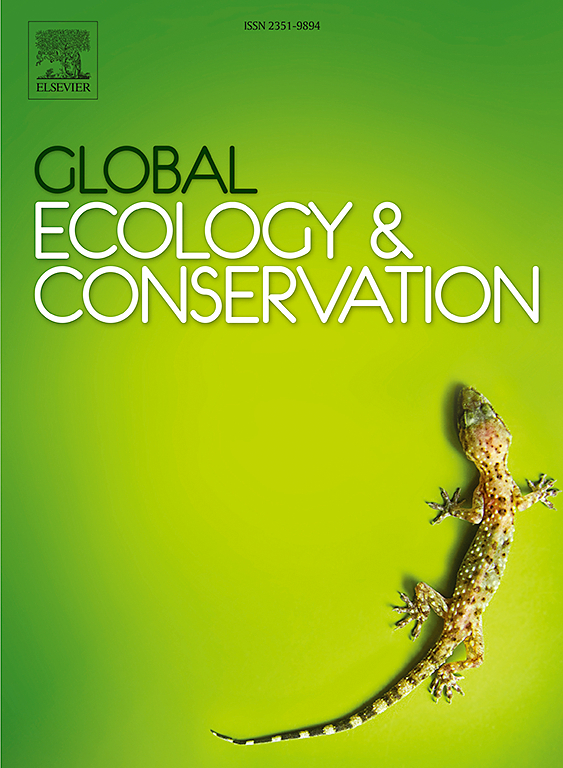空间聚类分析结合集合模型确定了红海白眼鸥潜在的海岸保护热点
IF 3.5
2区 环境科学与生态学
Q1 BIODIVERSITY CONSERVATION
引用次数: 0
摘要
红海的岛屿和沿海栖息地是各种特有动物物种的家园。然而,这些物种目前和未来的保护状况尚不清楚。其中一个物种是白眼鸥(Ichthyaetus leucophthalmus),这是红海地区的一种特有海鸟,在最热的月份(6月至8月)在地面筑巢。尽管该物种目前的知识状况,但关于其生物地理和空间分布对红海地区持续气候变化的响应的信息有限。在本研究中,我们采用空间聚类分析结合集合建模方法来预测白眼鸥的沿海分布,并确定潜在的热点。我们利用了两组来自海洋和陆地领域的当前环境变量和2050年的未来气候情景。我们的分析确定了13个对白眼鸥的保护至关重要的潜在热点。我们的研究结果表明,气候变化可能会显著影响白眼鸥的空间分布,可能会减少其目前的适宜栖息地,并将其范围进一步转移到红海北部,甚至可能转移到地中海。此外,我们的模型整合了海洋和陆地变量,预测白眼鸥的生物地理精度为88 - 95% %。我们的空间聚类分析与集成建模方法相结合,可以为确定适合白眼鸥栖息地的沿海地区的保护和管理策略提供信息。此外,它有可能应用于红海区域和其他地区具有类似生境要求的其他海鸟物种。本文章由计算机程序翻译,如有差异,请以英文原文为准。
Spatial clustering analysis combined with ensemble modeling identified potential coastal conservation hotspots of White-eyed gulls in the Red Sea
The islands and coastal habitats of the Red Sea are home to diverse and endemic animal species. However, the current and future conservation status of these species remains unclear. One such species is the White-eyed gull (Ichthyaetus leucophthalmus), an endemic seabird of the Red Sea region that nests on the ground during the hottest months, from June to August. Despite the species' current state of knowledge, there is limited information about its biogeography and spatial distribution in response to ongoing climatic changes in the Red Sea region. In this study, we used a spatial clustering analysis combined with an ensemble modeling approach to predict the coastal distribution and identify potential hotspots for the White-eyed gull. We utilized two sets of current environmental variables and future climatic scenarios for the year 2050 derived from both marine and terrestrial domains. Our analysis identified 13 potential hotspots that are crucial for the conservation of the White-eyed gull. Our findings reveal that climate change is likely to significantly impact the spatial distribution of the White-eyed gull, potentially reducing its current suitable habitats and shifting its range further into the northern Red Sea and possibly to the Mediterranean Sea. Additionally, our models, which integrate marine and terrestrial variables, predict the biogeography of the White-eyed gull with 88–95 % accuracy. Our spatial clustering analysis combined with an ensemble modeling approach can inform conservation and management strategies for coastal areas identified as suitable habitats for the White-eyed gull. Furthermore, it has the potential to be applied to other seabird species with similar habitat requirements in the Red Sea region and beyond.
求助全文
通过发布文献求助,成功后即可免费获取论文全文。
去求助
来源期刊

Global Ecology and Conservation
Agricultural and Biological Sciences-Ecology, Evolution, Behavior and Systematics
CiteScore
8.10
自引率
5.00%
发文量
346
审稿时长
83 days
期刊介绍:
Global Ecology and Conservation is a peer-reviewed, open-access journal covering all sub-disciplines of ecological and conservation science: from theory to practice, from molecules to ecosystems, from regional to global. The fields covered include: organismal, population, community, and ecosystem ecology; physiological, evolutionary, and behavioral ecology; and conservation science.
 求助内容:
求助内容: 应助结果提醒方式:
应助结果提醒方式:


